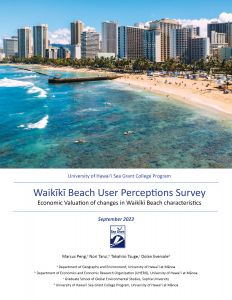Executive Summary
Waikīkī Beach accounted for some $7.8 billion in visitor expenditures in 2019, representing 38% of total visitor expenditures statewide. Though the economic value of Waikīkī Beach is considered to be substantial, few studies have estimated the value in a comprehensive manner. Non-market valuation studies of natural resources are sorely lacking in Hawai‘i, the last major beach valuation on Oʻahu dates back to 1975 (Moncur, 1975). Based on an in-person survey in Waikīkī Beach conducted in November 2019-January 2020 with 398 respondents, we estimate beach user’s willingness to pay (WTP) for changes in beach width and water clarity as well as the preferences for the beach as-is (under its current condition). Survey respondents differ in their attitudes toward beach renourishment. Those who do not support further erosion of the beach are willing to pay $389 for the beach as-is, $4.24 per additional foot of beach width on average, and $14.66 per additional foot of underwater visibility. The WTP for additional beach width drops as the beach becomes wider, but stays positive over the range of Waikīkī’s current beach width. The total WTP based on the estimated number of annual beachgoers in Waikīkī (including residents and visitors) is likely to exceed $1.8 billion for the beach as is; and $20 million for an increase in the beach width by 1 foot. These estimates clearly justify beach re-nourishment and runoff control measures to maintain the beach width and water visibility from an economic perspective.
A comprehensive assessment of the beach’s value would account for other types of benefits provided by the beach and the nearshore marine environment including ecosystem services, recreational values, aesthetics such as ocean and beach views, and mitigated storm damage to coastal properties among others. Though this study does not quantify these benefits, further application of the survey data and additional valuation surveys could address them to supplement the WTP estimates.
This study fills a gap in knowledge of the non-market recreational value of Waikīkī Beach, and Hawaii’s coastlines more broadly. In the context of continued beach erosion and high-tide events (“king tides”) in recent years, it is important to understand and quantify the perceived value of the beach itself and how resource management strategies such as beach nourishment can maintain and enhance the value of the beach and marine resources. It is particularly useful for managers to be informed of the trade-offs they face in management decisions. Changes in beach and nearshore conditions can have significant implications for economic welfare, especially in a high-density setting such as Waikīkī involving tourism, recreation, and natural resources. This study aims to inform policy and practice by estimating the value of the beach as-is, in addition to the value of increased beach width and associated water clarity.


